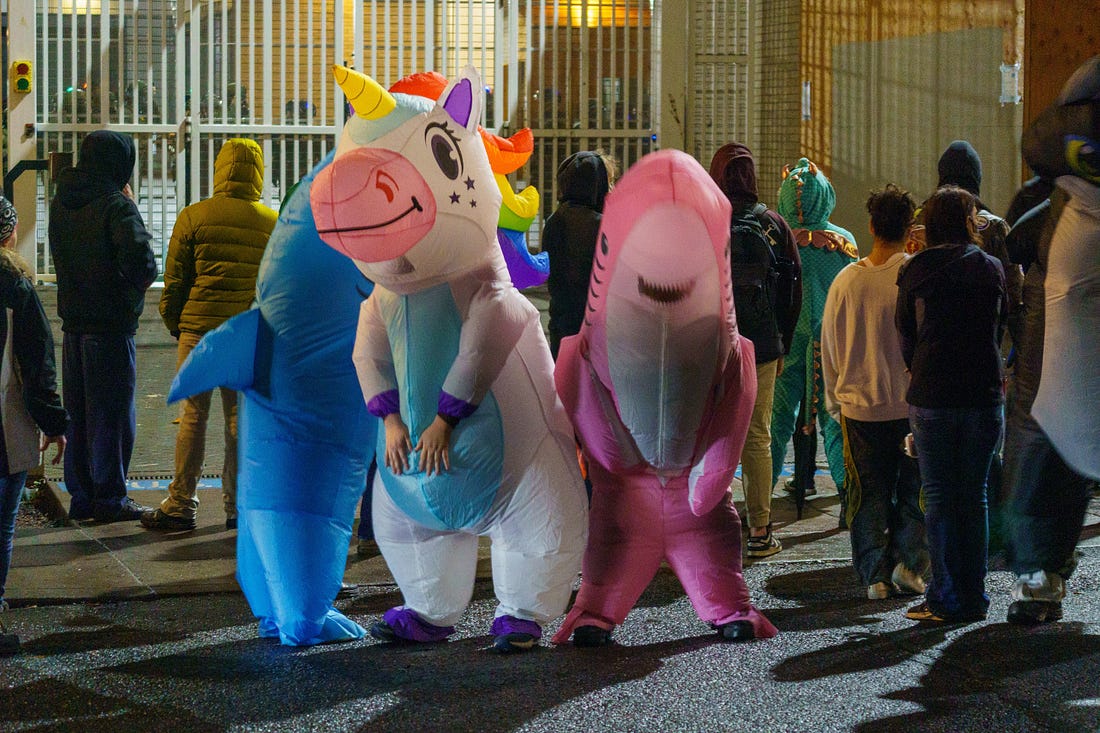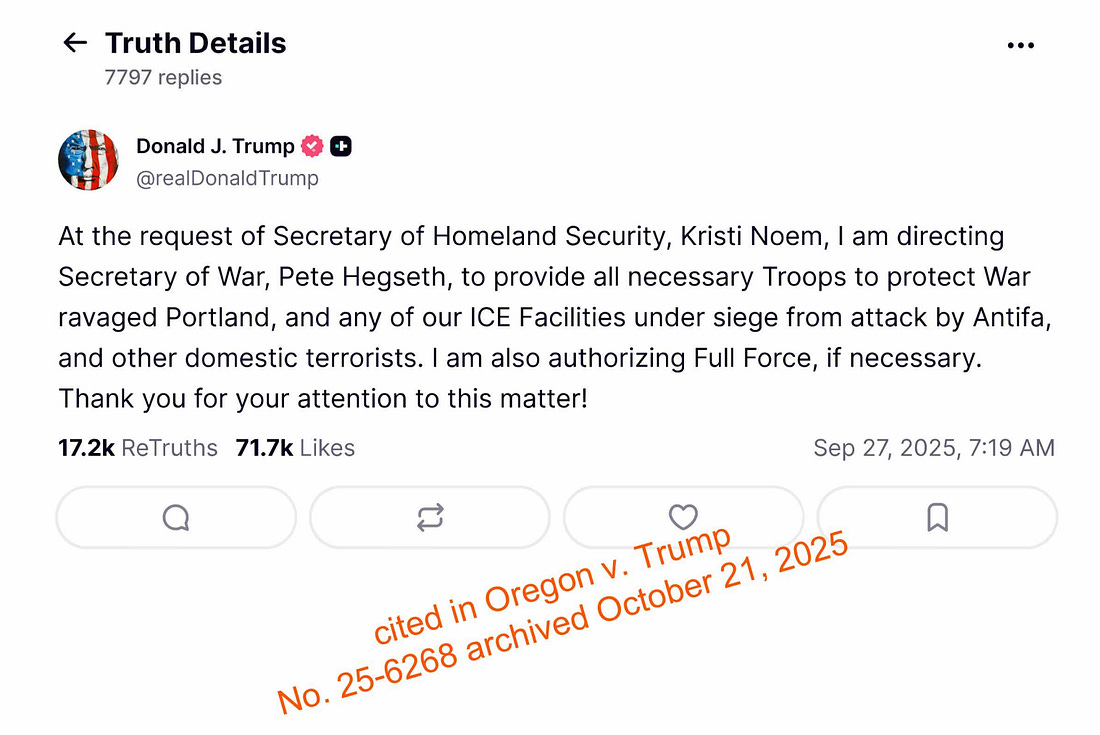If there’s one lesson of the Trump era, it’s that the president can lie with reckless abandon and face zero consequences. The jury’s still out on whether his underlings enjoy the same immunity. And by jury, we mean the Ninth Circuit Court of Appeals, which must now decide whether it matters that the Department of Justice told a lie in defense of the president’s raging whopper about hordes of ANTIFA laying waste to an immigration detention center in Portland, Oregon.
The genesis of this conflict is fittingly ridiculous. In September, Homeland Security spokesliar Tricia McLaughlin went on Fox News to spew nonsense about poor, beleaguered ICE agents being attacked as they went about their noble task of kidnapping every brown person they can get their hands on. Fox backed up McLaughlin’s pitch with B-roll from protests in Portland five years ago, which President Couch Potato decided was an accurate representation of the situation on the ground today. And despite the fact that the ICE facility in Portland drew only sporadic protests this year, Trump decreed that the city would be next on the list of Democratic strongholds to involuntarily host hundreds of federalized National Guard troops.
The DOJ scrambled to back-formulate a legal justification for this military onslaught, and, as in so many cases lately, it wasn’t too concerned about the veracity of its evidence. So now the Ninth Circuit Court of Appeals has to decide whether a comparatively little lie matters when they’ve already credited the big lie it supports.
Off to a Bad Start
In a very real sense, the Ninth Circuit laid this trap for itself in earlier litigation over National Guard troops in California. In June, trial Judge Charles Breyer issued a temporary restraining order declaring that none of the preconditions for federalizing the state militia under 10 U.S.C. § 12406 had been met: There was no invasion or rebellion in Los Angeles, and the president was not “unable with the regular forces to execute the laws of the United States.”
But a conservative panel of the Ninth Circuit, including two Trump appointees, disagreed. Citing the brief spasm of rioting — which was quickly put down by the Los Angeles Police Department — they determined that the president made a “colorable” claim that he was unable to execute the laws. The slim silver lining was that the panel in Newsom v. Trump was unwilling to cede the field entirely to the executive branch.
The Department of Justice takes the position that, whenever Trump declares an emergency under § 12406, his determination is absolutely unreviewable by any court. If the president says that there is rebellion, then there is rebellion, and no judge can decide whether he’s lying or not. The original Ninth Circuit panel rejected that maximalist argument, holding that, while they were obliged to “give a great level of deference to the President’s determination that a predicate condition exists,” the president’s determination is subject to judicial review.
But deference to the president’s claims, no matter how patently false, incentivizes the Justice Department to play fast and loose when called upon to invent post facto justifications — particularly this Justice Department. And because the Ninth Circuit got the first crack, their highly deferential standard was accepted by subsequent courts, including a second panel of Ninth Circuit judges that reviewed the Oregon National Guard deployment, as well as the Seventh Circuit’s review of the parallel case in Illinois.
Antifa Fantasies
Contrary to what the President says on social media, there is no “War” in Portland and no “ICE facilities under siege from attack by Antifa and other domestic terrorists.” There are, however, a lot of protesters dressed up as frogs and rainbow unicorns.
Nevertheless, the second Ninth Circuit panel considering Trump’s federalization order in Oregon found that the president’s emergency determination “reflects a colorable assessment of the facts and law within a range of honest judgment.”
That panel also had two Trump appointees, including Judge Ryan Nelson who penned a concurrence endorsing the DOJ’s previously-rejected assertion that the president’s emergency determination is “unreviewable by the federal courts.” To Nelson, “the President’s decision in this area is absolute,” so it doesn’t matter that Trump openly lies about imaginary Antifas conducting make-believe sieges.
As it turns out, Trump’s lackeys in the DOJ have also lied. A lot. In fact, while the Ninth Circuit was considering the Oregon federalization appeal, the DOJ admitted that one of its central claims in support of the emergency declaration was grossly inaccurate.
That lie came in a supporting affidavit by Robert Cantu, the Deputy Director of the Federal Protective Services, who attested that 115 of the 776 members of his agency had been forced to surge into Portland to protect its immigration facility:
The sustained violence associated with the protests in Portland has required FPS Region 10 to deploy officers from the other FPS Regions. To date, 115 FPS officers have had to deploy to Portland to maintain a 24/7 operational tempo. Removing these officers from their normal duty stations means that the buildings they are assigned to must rely on other FPS officers or the local police force to respond to law enforcement incidents. Moreover, the security related functions that the assigned officers normally perform end up being delayed.
Judge Nelson and Judge Bridget Bade, the two Trump appointees considering the appeal, cited Cantu’s declaration 18 times in the majority opinion, which bemoaned the “lack of support” from local law enforcement and the drain on operational capacity of federal law enforcement nationwide.
“The record reflects that 115 FPS officers—nearly 25% of FPS officers nationwide—were diverted to Portland” they tut-tutted. “The President may reasonably rely on this evidence in determining whether he is unable to execute the law.”
In dissent, Judge Susan Graber, a Clinton appointee, noted that something seemed fishy about Cantu’s “vague, carefully worded assertion.”
Crediting his assertion, we know that a total of 115 officers from elsewhere were deployed in Portland during the preceding four months. The record contains no information about how many officers were in Portland at any given time. For all we know, FPS sent a different 8 officers to Portland every week for 14 or 15 weeks, meaning that Portland’s drain on FPS’s staff from elsewhere on any particular day was 8 people, not 115. Indeed, the only description in the record of a “[s]urge” in officers was the deployment of 8 officers. The fact that there were 26 FPS officers on duty on September 6, as the majority’s order emphasizes, says nothing about whether any or all of those individuals were from somewhere other than Portland. The record does not reveal the number of local FPS officers.
The majority all but mocked Judge Graber, scoffing the she “only reaches a different conclusion by characterizing this evidence as ‘staffing difficulties’ and committing the same error as the district court in discounting, minimizing, and discrediting [the government’s] undisputed evidence on this point.”
Except that Judge Graber was absolutely right to discount, minimize, and discredit the government’s evidence. In discovery, FPS admitted that it did exactly what Graber suspected, rotating different officers through Portland each month and aggregating the total to make it appear as if the agency was dedicating a quarter of its resources to maintaining order in Portland. In reality, there are four agents permanently stationed in Portland, and FPS deployed waves of 27, 31, and 29 agents from other regions. In the month leading up to Trump’s emergency declaration, a mere 20 agents were pulled in. That does not support an honest judgment that Portland was under siege.
And the government repeated this lie in its brief opposing en banc reconsideration:
FPS, which is charged with protecting the Lindquist Building, is stretched to the point of collapse. The sustained violence and security risks have required FPS to provide 24/7 protection for the building, a task it is simply not resourced to accomplish. To date, 115 FPS officers have deployed to Portland in order to maintain this operational tempo. DHS has been forced to reassign members of Homeland Security Investigations (HSI) Portland’s Special Response Team (SRT) to support FPS, significantly impeding HSI’s ability to accomplish the missions with which SRT is tasked.
Lies, Lies, Lies
Lawyers for the state of Oregon flagged this “material factual error” in a supplement to its request for en banc review of the Nelson/Bade order. They noted the centrality of the Cantu affidavit to the ruling, and pointed out that the DOJ repeated the lie at oral argument:
The dissent noted that defendants’ declaration on the actual extent of the deployment was “carefully worded” to the point of “vague.” (Dissent 16-21). But defendants’ counsel emphasized at oral argument the “magnitude” and “unsustainab[ility]” of having 115 FPS offices redeployed; then, when asked directly whether all 115 officers remained in Portland, counsel stated only that “some” had gone home but “many” remained.
That looks like a deliberate attempt to mislead the court about the true state of the FPS deployment — yet another comparatively little lie in service of the much bigger one about “war ravaged” Portland. And it illustrates the folly of treating the president’s fact-free rantings as presumptively correct. Even with the court’s deferential thumb on the scale in favor of the president, the DOJ was still forced to backfill the tiny crack left for judicial review with slurry of falsehood and deception.
This episode highlights the disaster of the first Ninth Circuit panel’s ruling, which works from the premise that the president probably gets to declare reality by executive fiat, and then invites the DOJ to concoct a rationale to back it up. Because like ChatGPT, the Trump DOJ will come up with “facts” to support Trump’s claims — they just might not be true.
Whether this will wind up mattering remains to be seen. Senior Judge Sidney R. Thomas, the En Banc Coordinator for the Ninth Circuit, administratively stayed the Nelson/Bade order pending a vote by the full Ninth Circuit. In practical terms, that means that the Trump administration remains unable to deploy federalized national guard units to the streets of Portland until at least October 28 — and possibly longer if the court grants the motion for reconsideration. Will Trump then be allowed to flood the streets with soldiers based on an obvious lie, backed up by even more untruths?
As the state urged, “This Court must act swiftly to prevent defendants from attempting to benefit from their own material mistake to deploy military forces to peaceful civilian streets, contravening the rule of law and our nation’s history and traditions.”


